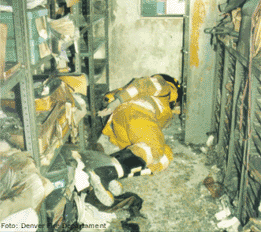This is a rhetorical analysis of a cover photo of the April 1993 issue of Fire Engineering magazine. Often controversial, the photo depicts a scene in which a firefighter died while battling a blaze in Denver in 1993. The article subsequently became a starting point for firefighter safety and reversed the stigma of one of the most deadly occupations in the United States.
A thumbnail of the photo with the magazine text removed.
 Do you think it’s possible to change an entire work force embedded with years of tradition, with a single click of the camera shutter? The artifact I chose is a magazine cover from the April 1993 issue of Fire Engineering. This cover had a profound effect on the fire service as a whole. The author, David McGrail, drove home his point with little text printed. The title of the magazine is on the top. The photo is of a fireman’s geared up body lying below a window face down in a charred room. Filing cabinets are on the right and shelving is on the left. The cover is neatly balanced with the words “Confined Space Claims Denver Firefighter”. If ever a photo can catch mesmerize a firefighter it would be one that shows a dead fireman. The purpose of the photo, to shock and awe, was fulfilled immensely. This particular fire where Mark Langvardt lost his life morphed into a training evolution that is drilled by thousands of firemen worldwide. While some may think this is an actual picture of Firefighter Langvardt in the position he died, it is not. This is a staged photo to create the conditions Mark faced in that early morning blaze. This “stage” resonates to generations of firefighters and hits at the core. The pathos of this photo is the very emotion that guides fireman daily – fear. Fear of not coming home to loved ones no matter the call. This cover proved to be very effective in a time before social media and the instant Internet. Today there is a drill called the Denver drill that firemen perform yearly.
Do you think it’s possible to change an entire work force embedded with years of tradition, with a single click of the camera shutter? The artifact I chose is a magazine cover from the April 1993 issue of Fire Engineering. This cover had a profound effect on the fire service as a whole. The author, David McGrail, drove home his point with little text printed. The title of the magazine is on the top. The photo is of a fireman’s geared up body lying below a window face down in a charred room. Filing cabinets are on the right and shelving is on the left. The cover is neatly balanced with the words “Confined Space Claims Denver Firefighter”. If ever a photo can catch mesmerize a firefighter it would be one that shows a dead fireman. The purpose of the photo, to shock and awe, was fulfilled immensely. This particular fire where Mark Langvardt lost his life morphed into a training evolution that is drilled by thousands of firemen worldwide. While some may think this is an actual picture of Firefighter Langvardt in the position he died, it is not. This is a staged photo to create the conditions Mark faced in that early morning blaze. This “stage” resonates to generations of firefighters and hits at the core. The pathos of this photo is the very emotion that guides fireman daily – fear. Fear of not coming home to loved ones no matter the call. This cover proved to be very effective in a time before social media and the instant Internet. Today there is a drill called the Denver drill that firemen perform yearly.
The photo/cover is arranged neatly and does not have distracting text. The manikin can be seen clearly thus giving the sense it is a real dead fireman. The picture is not over saturated with text, as most magazine covers seem to be today, thus decreasing chances of redundancy. Mr. McGrail did a good job with this stage. The yellow turnout gear, firefighter personal protective gear, has soot on it but not overpowering as to make the gear look unrealistic. With the photo being of a staged scene there is no repeating of colors or patterns. The placement of the manikin is key to the overall gut kick. There is a window above the head of the manikin. Observing a firefighter this close to a window begs you to ask, “Why didn’t he jump out the window?” A valid question is challenged when you notice the height of the windowsill. The size of the room and the height of the window made it nearly impossible to assist Mark out the window that morning. This is evident in the height of the windowsill.
The text type was simple as to not draw attention away from the main draw of the manikin. The size of the text complemented the print of the magazine title at the top. There were no other words on the cover. The image of the manikin placed in the narrowness of the space is centered. The visual effect that is created is effective to make you want to read the article about the line of duty death.
In April of 1993 this article was published to show the firefighting world that death can occur on this job. Prior to this article fireman knew that death is lurking around the corner every time you put on the gear. But everyone avoided talking about it. The photo, while criticized as being inappropriate, got many states to adopt firefighter safety classes and self-rescue techniques.


